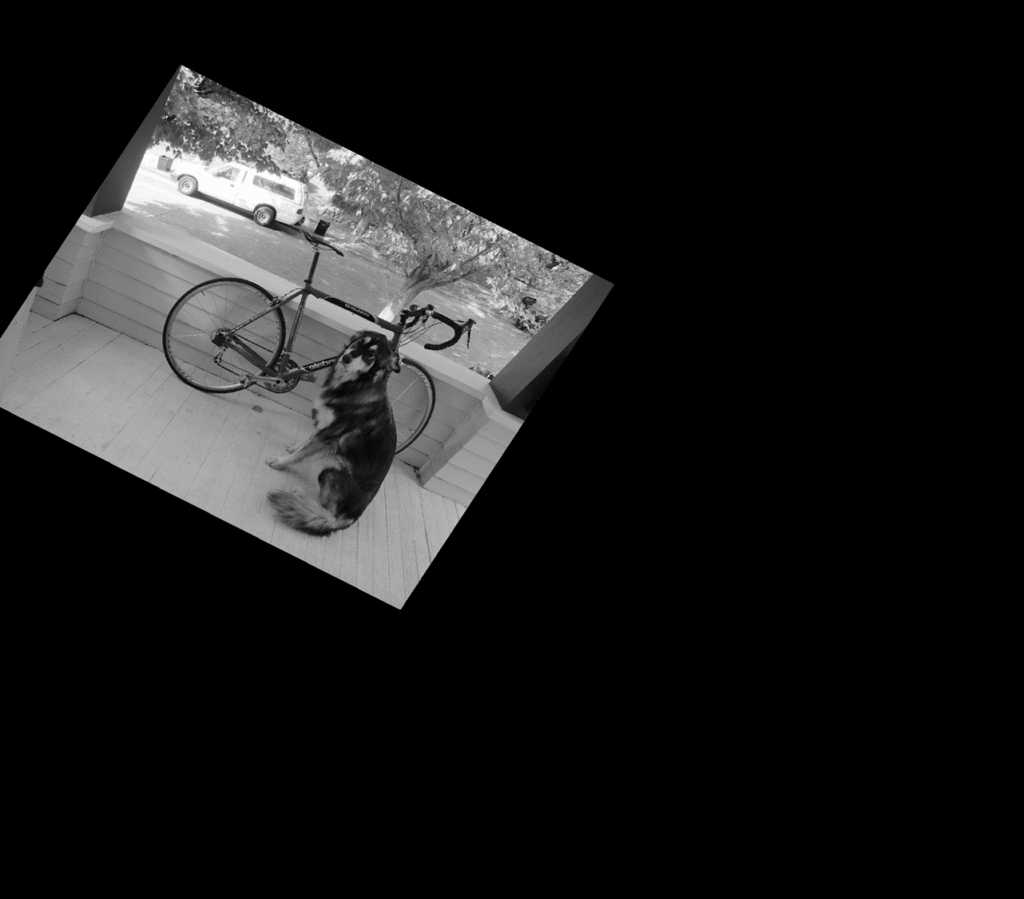MATLAB、Python、Scilab、Julia比較ページはこちら
https://www.simulationroom999.com/blog/comparison-of-matlab-python-scilab/
はじめに
の、
MATLAB,Python,Scilab,Julia比較 第3章 その84【アフィン行列の合成⑧】
を書き直したもの。
アフィン変換のアフィン行列の合成の話。
今回はPython(NumPy)で実施する。
【再掲】プログラムで実現したいアフィン行列の合成
まずは、実現したいアフィン行列の合成。
\(
\begin{eqnarray}
\begin{bmatrix}
x\prime\\
y\prime\\
1
\end{bmatrix}=
\begin{bmatrix}
1 & m_x & 0 \\
m_y & 1 & 0 \\
0 & 0 & 1
\end{bmatrix}
\begin{bmatrix}
\cos(30^\circ) & -\sin(30^\circ) & 0 \\
\sin(30^\circ) & \cos(30^\circ) & 0 \\
0 & 0 & 1
\end{bmatrix} \\
\begin{bmatrix}
1 & 0 & T_x \\
0 & 1 & T_y \\
0 & 0 & 1
\end{bmatrix}
\begin{bmatrix}
S_x & 0 & 0 \\
0 & S_y & 0 \\
0 & 0 & 1
\end{bmatrix}
\begin{bmatrix}
x\\
y\\
1
\end{bmatrix}
\end{eqnarray}
\)
そして、アフィン逆変換のアルゴリズム都合で実際に使用する数式がこれ。
\(
\begin{eqnarray}
\begin{bmatrix}
x\\
y\\
1
\end{bmatrix}=
\begin{bmatrix}
S_x & 0 & 0 \\
0 & S_y & 0 \\
0 & 0 & 1
\end{bmatrix}^{-1}
\begin{bmatrix}
1 & 0 & T_x \\
0 & 1 & T_y \\
0 & 0 & 1
\end{bmatrix}^{-1}
\begin{bmatrix}
\cos(30^\circ) & -\sin(30^\circ) & 0 \\
\sin(30^\circ) & \cos(30^\circ) & 0 \\
0 & 0 & 1
\end{bmatrix}^{-1}\\
\begin{bmatrix}
1 & m_x & 0 \\
m_y & 1 & 0 \\
0 & 0 & 1
\end{bmatrix}^{-1}
\begin{bmatrix}
x\prime\\
y\prime\\
1
\end{bmatrix}
\end{eqnarray}
\)
これをPython(NumPy)で実現する。
Pythonコード
Pythonコードは以下になる。
import numpy as np
import cv2
# アフィン変換関数
def affine_transformation(img, matrix):
# 画像サイズ取得
hight, width = img.shape
# 中心を0とした座標系を生成
x_axis = np.linspace(-1, 1, width);
y_axis = np.linspace(-1, 1, hight);
xim,yim = np.meshgrid(x_axis, y_axis);
# 座標x,y,1の3次元ベクトルの配列
# reshapeで行ベクトル化、「*」で式展開
points=np.array([[*xim.reshape(width*hight)],
[*yim.reshape(width*hight)],
[*np.ones((width*hight))]])
# 変換元座標算出(アフィン逆変換)
points_affine = matrix @ points;
# 画像と同一形状の2次元配列に変換元座標配列を生成
dx = points_affine[0,:].reshape(hight,width)
dy = points_affine[1,:].reshape(hight,width)
# 変換元座標をピクセル位置に変換
v = np.clip((dx + 1) * width / 2, 0, width-1).astype('i')
h = np.clip((dy + 1) * hight / 2, 0, hight-1).astype('i')
# 元画像と変換元座標を元に変換先へコピー
return img[h, v]
# キャンパス拡張
def canvas_expansion(img, x, y):
H,W=img.shape
WID=W+x
HID=H+y
e_img = np.zeros((HID, WID),dtype='uint8')
e_img[int((HID-H)/2):int((HID+H)/2), int((WID-W)/2):int((WID+W)/2)] = img;
img = e_img
return img
def affine_transformation_test():
# 入力画像の読み込み
img = cv2.imread("dog.jpg")
b = img[:,:,0]
g = img[:,:,1]
r = img[:,:,2]
# SDTVグレースケール
img = np.array(0.2990 * r + 0.5870 * g + 0.1140 * b, dtype='uint8')
# キャンパス拡張
img = canvas_expansion(img, 800, 800)
sx = 1;
sy = -1;
tx = 0.5;
ty = 0;
theta = 150/180*np.pi;
mx = np.tan(0/180*np.pi);
my = np.tan(0/180*np.pi);
scaling_matrix = np.array([[ sx, 0, 0],
[ 0, sy, 0],
[ 0, 0, 1]])
scaling_matrix = np.linalg.inv(scaling_matrix)
translation_matrix = np.array([[ 1, 0, tx],
[ 0, 1, -ty],
[ 0, 0, 1]]);
translation_matrix = np.linalg.inv(translation_matrix)
rotation_matrix = np.array([[ np.cos(theta), -np.sin(theta), 0],
[ np.sin(theta), np.cos(theta), 0],
[ 0, 0, 1]]);
shear_matrix = np.array([[ 1, -mx, 0],
[-my, 1, 0],
[ 0, 0, 1]]);
shear_matrix = np.linalg.inv(shear_matrix)
matrix = scaling_matrix@translation_matrix@rotation_matrix@shear_matrix;
# アフィン変換
affine_img = affine_transformation(img, matrix)
# グレースケール画像表示
cv2.imshow('image',affine_img)
cv2.waitKey(0)
# グレースケール画像の書き込み
cv2.imwrite("dog_affine.jpg", affine_img)
return;
affine_transformation_test()処理結果
処理結果は以下。

考察
これも動作はOK。
処理の手順としてはMATLABと一緒。
三角関数とかは様々なライブラリでもサポートしていることは多いが、
ここではNumPyが持ってる関数を使用している。
細かい精度の違いなどあるかもしれないが、そこは特に調べてない。
まとめ
- Python(NumPy)でアフィン行列の合成を実施。
- 問題無く動作。
- 三角関数ははNumPyが持っているものを使用。
- 他のライブラリも三角関数を持っていることが多い。
- 精度の違い等があるかもしれないが調べてない。
- 他のライブラリも三角関数を持っていることが多い。
MATLAB、Python、Scilab、Julia比較ページはこちら





コメント